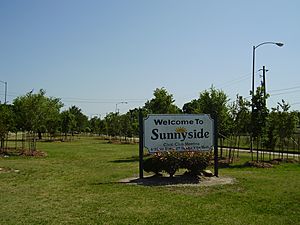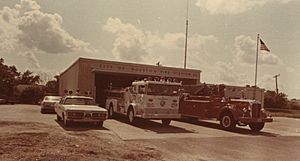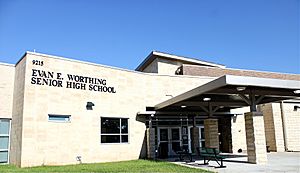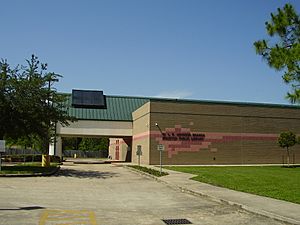Sunnyside, Houston facts for kids
Sunnyside is a community in southern Houston, Texas, United States, south of Downtown Houston.
Sunnyside is outside the 610 Loop and inside Beltway 8 off State Highway 288 south of Downtown Houston and is predominantly African American. The community's slogan is "Sunnyside Pride." Sunnyside included a landfill, an adjacent garbage incinerator, and several salvage yards; the incinerator has closed. The city of Houston describes Sunnyside's housing as "suburban-style." As of 2007 Sandra Massie-Hines is the honorary mayor of Sunnyside.
Contents
History
Thousands of enslaved African-Americans lived near Houston before the Civil War. Many of them near the city worked on sugar and cotton plantations, while most of those in the city limits had domestic and artisan jobs. In 1860, 49% of the city's population was enslaved.
African Americans started to settle in the community and it was founded by H. H. Holmes. Sunnyside, the oldest African-American community in southern Houston, was first platted in 1912. When the community opened in the 1910s, H. H. Holmes, the founder, gave the land the name Sunny Side. By the 1940s area residents established a water district and a volunteer fire department. The City of Houston annexed Sunnyside in 1956.
From the 1980 U.S. Census to the 1990 Census, many African-Americans left traditional African-American neighborhoods like Sunnyside and entered parts of Southwest Houston. Sunnyside lost 30% of its population in the decade prior to August 20, 1992.
Between 1990 and 2000 the Hispanic population of Sunnyside increased a little by between 5 and 10 percent.
A 2013 NeighborhoodScout crime study that analyzed data from the Federal Bureau of Investigation (FBI) concluded that Sunnyside was #6 in its list of the 25 most dangerous neighborhoods in the United States. According to the ranking, every year each Sunnyside resident had a 1 in 11 chance of becoming a victim of crime, and the violent crime rate was 91.27 out of 1,000.
Demographics
In 1980 64% of residents owned their houses.
According to the 1990 Census Sunnyside had 3,484 residents. 93.8% of them were African-American, 4.2% were Hispanic, and 2% were White, Asian, or other. The median household income was $12,477, compared to the City of Houston median of $26,621. 38.6% of Sunnyside residents lived below the poverty line. As of that year, in the wider area, 1.5% were Hispanic.
In 2000 the City of Houston-defined Sunnyside Super Neighborhood had 18,629 residents. 93% were non-Hispanic black, 4% were Hispanic, and 1% each were non-Hispanic white, Asian, and others.
In 2010 the home ownership rate was 46%. As of 2016 about 22,000 people lived in the Sunnyside area, with 97% being black and 10% being Hispanic.
In 2006, the unemployment rate was 12%. In 2016 it was 29%, the highest percentage of any community in Houston; the city's overall unemployment rate was 5.5%.
In 2010 4,576 households had salaries under $25,000 annually. Circa 2016 about 30% of the households were poorer than the defined poverty line, and 5,062 households made under $25,000 annually.
In 2015 the super neighborhood had 20,071 residents. 88% were non-Hispanic black, 10% were Hispanic, and 1% each were non-Hispanic white and other. The percentage of non-Hispanic Asians was zero.
Cityscape
Rafael Longoria and Susan Rogers of the Rice Design Alliance said that Sunnyside could be described as "rurban," a word coined in 1918 which describes an area with a mix of urban and rural characteristics. By 2007 new houses began to appear in the area. As of 2008 Sunnyside still has small churches, shotgun houses, horse stalls, original frame houses, open ditches, uncontrolled garbage fires, and vacant lots, features which characterize many rural areas. By 2008 a major landfill and incinerator in the area had been converted into a park.
As of 2010 Sunnyside has two grocery stores within its area, which serve a regional population of 22,000. Toral Sindha, a nutritionist in the City of Houston's health department and the manager of the city's Community Garden Program, stated that because of this Sunnyside was "a true food desert" and that "healthy produce in fresh fruits and vegetables is not accessible in Sunnyside." Cindy George of the Houston Chronicle said during that year that in Sunnyside and several other communities in Houston, "an abundance of drive-throughs and convenience stores offer processed, fatty foods to residents." George added that Sunnyside's neighborhood stores "offer fewer healthy options of any kind."
Villa Americana formerly known as the VA, Wesley Square, Sunflower Terrace formerly known as Jailhouse, Scott Plaza, King's Row, Royal Palms East, Southlawn, Missionary Village, and the now demolished Wilmington are low income housing developments located around the area.
Parks and recreation
The city operates the Sunnyside Park and the Sunnyside Community Center at 3502 Bellfort Boulevard. The park and the community center include a playground, an outdoor basketball pavilion, a 0.48 miles (0.77 km) hike and bicycle trail, lighted tennis courts, an indoor gymnasium, weight rooms, meeting rooms, a lighted athletics field, and a swimming pool. The community celebrates the "Chocolate Bayou" festival annually. Sunnyside is included in the service area of the Sam Houston Area Council Boy Scouts W.L. Davis District.
Community services
The American Red Cross operates the Southeast (Sunnyside) Houston-Harris County Branch Office at 4605 Wilmington Street.
Gallery
Economy
In the 1970s and 1980s the area was known as "Black Wall Street" or "Baby River Oaks" due to the concentration of businesses. The 1980s oil bust damaged the Sunnyside economy. There were 800 businesses in Sunnyside in 2006; the 2000s-2010s Great Recession further harmed Sunnyside particularly because many businesses had thin operating margins; many African-American businesses received above-average damage from the 2008 recession, and new ones had since been established in Missouri City and Pearland. In 2016 the number of businesses in Sunnyside was 600, a 25% decrease from 2006.
Education
Primary and secondary schools
Public schools
The community is zoned to Houston Independent School District (HISD) schools. The community is within Trustee District IV, represented by Paula M. Harris as of 2008.
The schools serving Sunnyside proper include Young Elementary School, Attucks Middle School, and Worthing High School. Worthing is located in Sunnyside.
Young Elementary opened as Sunny Side Elementary School in 1918; HISD renamed the school in June 1999 after Sunnyside residents petitioned for a renaming of the school. Young shares its campus with South Administrative Alternative Elementary. Worthing was built in 1958, and it opened on January 27, 1958. Prior to the opening of Worthing, students went to Miller Junior High School and Yates High School. After Worthing received a new campus in 1962, Worthing moved out of its former campus, where Attucks opened.
Carnegie Vanguard High School, an HISD magnet school, was previously near Sunnyside. In 2008 Carnegie Vanguard was chosen as a National Blue Ribbon School. Carnegie was scheduled to move to the Fourth Ward.
Charter schools
The Sunnyside area has the following state charter schools:
KIPP Houston Public Schools operates three charter schools on the same site: KIPP Zenith Academy (grades K-4), established in 2009; KIPP Spirit College Prep (grades 5-8), established in 2006; and KIPP Sunnyside High School (KSHS), which opened in 2010. KIPP Sunnyside HS serves students from the Sunnyside, Third Ward, and Hiram Clarke areas. KIPP Zenith opened as part of a wave of KIPP elementary schools opening at the same time.
YES Prep Public Schools operates YES Prep Southside in Sunnyside. The school is open to children from the Sunnyside, Third Ward, OST, South Park and Old South Union neighborhoods. YES Prep Southside opened in the 2015-2016 school year with a 6th grade class, and will continue to add a grade each year until it has 6th-12th grades.
Pro-Vision Academy, in Sunnyside, relocated to there in November 2008. Pro-Vision was the first all male middle charter school in the State of Texas. Pro-Vision All Male Middle Charter School was established in 1995. Pro-Vision serves grades 5th - 8th. Now since 2014 Pro-Vision welcomes female students and is now an athletic school
Crossroads Charter is located in a four-story office building in the area.
Private schools
A Kindergarten through 5 Roman Catholic school called St. Philip Neri School, of the Roman Catholic Archdiocese of Galveston-Houston, was in the area. It closed in Spring 2009. The school was consolidated with St. Peter the Apostle Middle School, located in the Third Ward area, which became PK-8 and ultimately closed in 2019.
Gallery of public schools
Public libraries
The W. L. D. Johnson Neighborhood Library of Houston Public Library is located at 3517 Reed Road. The library was named after W.L.D. Johnson, Sr., a man who raised funds for the purchase of the Carnegie Colored Library and served on the board of directors of that library. This branch, dedicated on June 16, 1964, replaced the Carnegie Colored Library.
Notable residents
- Alma Allen - Member of the Texas House of Representatives
- Rodney Ellis - Member of the Texas Senate
- Travis Scott
Images for kids












